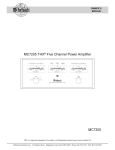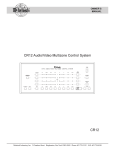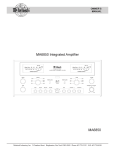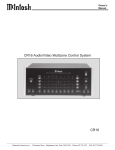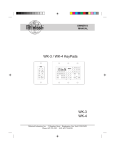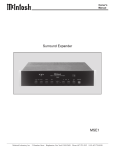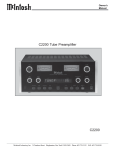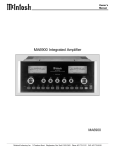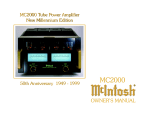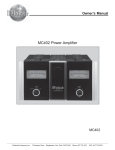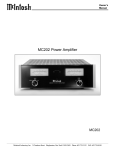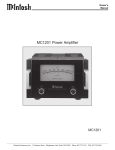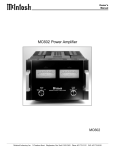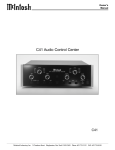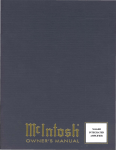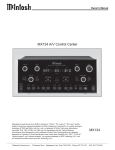Download McIntosh HT-3 Owner`s manual
Transcript
OWNERS MANUAL Surround Decoder, Dolby Digital (AC-3), DTS and THX Dolby, AC-3, Pro Logic and the Double D symbol are registered trademarks of Dolby Laboratories and manufactured under license from Dolby Laboratories. DTS, digital surround, and coherent acoustics are registered trademark of DTS Technology LLC. and manufactured under license from DTS Technology LLC. THX and Re-EQ + TM are registered trademarks of Lucasfilm, Ltd and manufactured under license from Lucasfilm Ltd. MSD4 McIntosh Laboratory, Inc. 2 Chambers Street Binghamton, New York 13903-2699 Phone: 607-723-3512 FAX: 607-724-0549 Thank You, Please Take A Moment, Customer Service and Table of Contents Thank You Table of Contents For your decision to own this McIntosh MSD4 Surround Decoder ranks you at the very top among discriminating music listeners. You now have The Best. The McIntosh dedication to Quality, is assurance that you will receive many years of musical enjoyment from this unit. Please take a short time to read the information in this manual. We want you to be as familiar as possible with all the features and functions of your new McIntosh MSD4. This will ensure that you receive all the performance benefits this equipment can offer you, and that it will become a highly valued part of your home entertainment system. Thank You .......................................................................... 2 Please Take a Moment ....................................................... 2 Customer Service ............................................................... 2 Table of Contents ............................................................... 2 Safety Instructions ............................................................. 3 Introduction ....................................................................... 4 Performance Features ........................................................ 4 Installation ......................................................................... 6 Rear Panel Switches and Connections .............................. 7 How to Connect with a C39/MX130 ................................. 8 How to Connect in a Stand Alone System ......................... 9 Front Panel Controls, Push-Buttons, Switches and Displays ..................................................... 10 Delay Calibration for Center and Surround Channels .......................................................... 11 How to Operate with a C39/MX130 ............................... 12 System Level Calibration ................................................ 14 How to Operate in a Stand Alone System ....................... 16 Specifications .................................................................. 18 Packing Instruction .......................................................... 19 Please Take A Moment The serial number, purchase date and McIntosh dealer name are important to you for possible insurance claim or future service. The serial number is located on the rear panel of the equipment. The spaces below have been provided for you to record that information: Serial Number: Purchase Date: Dealer Name: Customer Service If at any time you have questions about your McIntosh MSD4 Surround Decoder, contact your McIntosh dealer. Your dealer is familiar with your McIntosh equipment as well as other brands that may be included in your system and is best qualified to help you. If it is determined that your MSD4 is in need of repair, you can return it to your dealer or you can return it to McIntosh Laboratory. Contact the McIntosh Repair Department for assistance at, McIntosh Laboratory, Inc. 2 Chambers Street Binghamton, New York 13903 Phone: 607-723-3512 FAX: 607-724-0549 Copyright 1998 by McIntosh Laboratory, Inc. 2 NOTES: 1. The MSD4 can be operated with a McIntosh C39 or MX130 Control Center. It may also be operated with a McIntosh MVS-3 Audio/Video Selector and a MC7205 Power Amplifier. There are instructions to cover both possibilities. Please refer to the following listing as a guide: For use with a McIntosh C39 or MX130 How to Connect with a C39/MX130 ................................. 8 Delay Calibration for Center and Surround Channels .......................................................... 11 How to Operate with a C39/MX130 ............................... 12 For use with a McIntosh MVS-3 and MC7205 How to Connect in a Stand Alone System ......................... 9 Delay Calibration for Center and Surround Channels .......................................................... 11 System Level Calibration ................................................ 14 How to Operate in a Stand Alone System ....................... 15 2. Connecting Cables are available from the McIntosh Parts Department: Data and Power Control Cable Part No. 170-202 Six foot, shielded 2 conductor, with 1/8 inch stereo mini phone plugs on each end. 3. For additional connection information, refer to the owners manual(s) for any component(s) connected to the MSD4 Surround Decoder. Safety Instructions IMPORTANT SAFETY INSTRUCTIONS! PLEASE READ THEM BEFORE OPERATING THIS EQUIPMENT. WARNING SHOCK HAZARD DO NOT OPEN. The lightning flash with arrowhead, within an equilateral triangle, is intended to alert the user to the presence of uninsulated dangerous voltage within the products enclosure that may be of sufficient magnitude to constitute a risk of electric shock to persons. AVIS RISQUE DE CHOC NE PAS OUVRIR. The exclamation point within an equilateral triangle is intended to alert the user to the presence of important operating and maintenance (servicing) instructions in the literature accompanying the appliance. NO USER-SERVICEABLE PARTS INSIDE. REFER SERVICING TO QUALIFIED PERSONNEL To prevent the risk of electric shock, do not remove cover (or back). No user serviceable parts inside. Refer servicing to qualified personnel. General: 1. Read all the safety and operating instructions, contained in this owners manual, before operating this equipment. 2. Retain this owners manual for future reference about safety and operating instructions. 3. Adhere to all warnings and operating instructions. 4. Follow all operating and use instructions. 5. Warning: To reduce risk of fire or electrical shock, do not expose this equipment to rain or moisture. This unit is capable of producing high sound pressure levels. Continued exposure to high sound pressure levels can cause permanent hearing impairment or loss. User caution is advised and ear protection is recommended when playing at high volumes. 6. Caution: to prevent electrical shock do not use this (polarized) plug with an extension cord, receptacle or other outlet unless the blades can be fully inserted to prevent blade exposure. Attention: pour pevenir les chocs elecriques pas utiliser cette fiche polarisee avec un prolongateur, une prise de courant ou un autre sortie de courant, sauf si les lames peuvent etre inserees afond ans en laisser aucune partie a decouvert. 7. For added protection for this product during a lightning storm, or when it is left unattended and unused for long periods of time, unplug it from the wall outlet and disconnect the antenna or cable system. This will prevent damage to the product due to lightning or power line surges. 8. Do not use attachments not recommended in this owners manual as they may cause hazards. Installation: 9. Locate the equipment for proper ventilation. For example, the equipment should not be placed on a bed, sofa, rug, or similar surface that may block ventilation openings; or, placed in a built-in installation, such as a bookcase or cabinet, that may impede the flow of air through the ventilation openings. 10. Locate the equipment away from heat sources such as radiators, heat registers, stoves, or other appliance (including amplifiers) that produce heat. 11. Mount the equipment in a wall or cabinet only as described in this owners manual 12. Do not use this equipment near water; for example, near a bathtub, washbowl, kitchen sink, laundry tub, in a wet basement or near a swimming pool, etc. 13. Do not place this product on an unstable cart, stand, tripod, bracket, or table. The equipment may fall, causing serious injury to a person, and serious damage to the product. Connection: 14. Connect this equipment only to the type of AC power source as marked on the unit. 15. Route AC power cords so that they are not likely to be walked on or pinched by items placed upon or against them, paying particular attention to cords at plugs, convenience receptacles, and the point where they exit from the instrument. 16. Do not defeat the inherent design features of the polarized plug. Non-polarized line cord adapters will defeat the safety provided by the polarized AC plug. If the plug should fail to fit, contact your electrician to replace your obsolete outlet. Do not defeat the safety purpose of the grounding-type plug. 3 Safety Instructions cont, Introduction and Performance Features 17. Do not overload wall outlets, extension cords or integral convenience receptacles as this can result in a risk of fire or electric shock. Care of Equipment: 18. Clean the instrument by dusting with a dry cloth. Unplug this equipment from the wall outlet and clean the panel with a cloth moistened with a window cleaner. Do not use liquid cleaners or aerosol cleaners. 19. Do not permit objects of any kind to be pushed and/or fall into the equipment through enclosure openings. Never spill liquids into the equipment through enclosure openings. 20. Unplug the power cord from the AC power outlet when left unused for a long period of time. Repair of Equipment: 21. Unplug this equipment from the wall outlet and refer servicing to a qualified service personnel under the following conditions: A. The AC power cord or the plug has been damaged. B. Objects have fallen, or liquid has been spilled into the equipment. C. The equipment has been exposed to rain or water. D. The equipment does not operate normally by following the operating instructions contained within this owners manual. Adjust only those controls that are covered by the operating instructions, as an improper adjustment of other controls may result in damage and will often require extensive work by a qualified technician to restore the product to its normal operation. E. The equipment has been dropped or damaged in any way. F. The equipment exhibits a distinct change in performance - this indicates a need for service. 22. Do not attempt to service beyond that described in the operating instructions. All other service should be referred to qualified service personnel. 23. When replacement parts are required, be sure the service technician has used replacement parts specified by McIntosh or have the same characteristics as the original part. Unauthorized substitutions may result in fire, electric shock, or other hazards. 24. Upon completion of any service or repairs to this product, ask the service technician to perform safety checks to determine that the product is in proper operating condition. 4 Introduction The McIntosh MSD4 is a precision Dolby Digital AC-3®, DTS surround decoder which will reproduce the six discrete channels of encoded sound tracks with ultimate fidelity and sonic purity. The MSD4 also incorporates a Dolby Pro Logic® surround decoder to reproduce Dolby Surround® sound tracks with superior audio quality. The MSD4 has many valuable and useful features that will enhance your listening experience. Performance Features · Remote Controlled by a C39 or MX130 When used with a C39 or MX130, the MSD4 inputs can be selected by remote control. · Assemble a Simplified Surround Sound System Use an MSD4 as a stand alone decoder with a McIntosh MVS-3 Audio/Video Selector, an MC7205 Five Channel Power Amplifier and an SL-1 Powered Subwoofer for a simplified Dolby Digital, Pro Logic or DTS Surround Sound System. · 24 Bit DSP Processing Three Motorola 24 Bit Digital Processors decode Dolby Digital, Pro Logic and DTS signals. This combination is one of the most powerful processing systems available. · 24 Bit Conversion Three 24 bit stereo digital to analog, (D/A) converters are used to reproduce the six decoded Dolby Digital or DTS audio channels, and one 24 bit stereo analog to digital, (A/ D) converter is for signals fed into the analog inputs. · Digital Input Switching Four Digital Coaxial and matching Optical inputs are provided for four program sources: 1. Digital Versatile Disc (DVD) 2. Laser Video Disc Player (LV) 3. Satellite Tuner or Receiver (SAT) 4. CD Player (CD1) The LV AC-3 RF INPUT receives RF signals from a Laser Video Disc Player reproducing Dolby Digital sound tracks. The ANALOG Stereo Input accept stereo signals from any audio source. Performance Features cont · Automatic Mode Switching The MSD4 automatically switches operating modes between Dolby Digital, Pro Logic or DTS, according to the input signals. · LED Channel Status Indicators The MSD4 includes seven LEDs on the front panel to indicate what type of operating signals are being received. · Front Panel Mode Nomenclature Dolby Digital, Pro Logic or DTS nomenclature illuminates to show which decoding mode is in use. · Adjustable Channel Time Delays Signals to the Center channel and Surround channels can be time delayed. This feature can be used to correct for different listening distances from the center speaker and surround speakers relative to the front speakers. · Precision Tracking Volume Control An electronic Volume Control adjusts all six channels with tracking accuracy better than 0.5dB. · Automatic Input Level Control The Analog Input includes a special circuit which protects against accidental input signal overdrive. · IR Remote Control When used in a simplified system with the MVS-3 and MC7106, the MSD4 can be controlled directly with an optional Remote Control (HR34/HR39/HR130) through its front panel IR (Infra Red) sensor. · Speaker Settings for Bass Management The MSD4 processing circuits allow you to change the bass cutoff frequency fed to the front, center and surround channels to 80Hz, when using a subwoofer. · Automatic Power On-Off The MSD4 AC power can be turned on or off with a Power Control signal from a McIntosh Control Center or other McIntosh accessory component. · LED Delay/Volume Indicator The front panel two digit LED reads Volume in percent. It also indicates time delay in milliseconds during time delay calibration, and channel level in dB during surround level calibration. · Built-In System Level Calibration Generator A built-in test signal generator can be switched manually or automatically through all system channels for surround level calibration. The levels can be adjusted plus or minus 12dB. · Re-EQ + TM Re-Equalization filter and Timbre Matching modify the sound tracks created for a large theater so they are more enjoyable in the smaller listening room of a home theater. · Late Night Dynamic Audio Compression With select encoded Dolby Digital sound tracks, a dynamic volume level compressor can be switched in to reduce the wide dynamic range of music and sound effects. This feature can be very useful for late night listening or when you have close neighbors. 5 Installation Installation The MSD4 can be placed upright on a table or shelf, standing on its four feet. It also can be custom installed in a piece of furniture or cabinet of your choice. The required panel cutout, ventilation cutout and unit dimensions are shown. Always provide adequate ventilation for your MSD4. Cool operation ensures the longest possible operating life for any electronic instrument. Do not install the MSD4 directly above a heat generating component such as a high powered amplifier. If all the components are installed in a single cabinet, a quiet running ventilation fan can be a definite asset in maintaining all the system components at the coolest possible operating temperature. A custom cabinet installation should provide the following minimum spacing dimensions for cool operation. Allow at least 1-1/2 inches (3.8cm) above the unit so airflow is not obstructed. Allow 17-1/2 inches (44.5cm) depth behind the mounting panel, which includes clearance for connectors. Allow 1-1/8 inches (2.9cm) in front of the mounting panel for knob clearance. Be sure to cut out a ventilation hole in the mounting shelf according to the dimensions in the drawing. 17-1/2" 444mm 7/32" 5.3mm 17-1/16" 433.4mm 1/4" 6mm Front View of a MSD4 custom installed Outline of Front Panel Edge of Cutout End Caps 3-9/16" 90.0mm 3-1/16" 77.8mm Panel Height 3 1/2" 88.9mm (Front View) 3/16" 5.1mm Support Shelf Bottom of Cutout and Top of Support Shelf Must Coincide Mounting Surface Mounting Bracket at Both Sides of the Rear Panel. Fasten with 6-32 x 3/8 Machine Screw and Washer to Chassis. Fasten with 6 x 1/2 Wood Screw and Washer to Support Shelf Outline of Unit Side View of a MSD4 custom installed (Side View) Support Shelf Mounting Surface 15" Bottom View of a MSD4 custom installed 6" Cut Out Center for Ventilation (Bottom View) 9" 6 Rear Panel Switches and Connections Rear Panel Switches and Connections When the MSD4 is being used in a system with a C39 or MX130 the POWER CONTROL IN receives turn on and off signals from the McIntosh Control Center.The POWER CONTROL OUT jack sends a turn on and off signal out to a McIntosh Power Amplifier Connect the MSD4 power cord to a live AC outlet. Refer to information on the back panel of your MSD4 to determine the correct voltage for your unit Set the FP SENSOR (Front Panel Sensor) slide switch to the OFF position when the MSD4 is being used in a system with a C39 or MX130. Set the FP SENSOR slide switch to the ON position when the MSD4 is being used as a stand alone decoder together with an MVS-3, MC7205 and SL-1 in a simplified surround system The SPEAKER SETTINGS switches adjust the bass frequency response to the correct frequency ranges to match the sizes of the front, center and surround speakers. If any speaker in the system is classed as small, frequencies from 80Hz and lower can be switched to the subwoofer output. Set the SUBWOOF switch to ON only when a subwoofer is used in the system Receives RF signal from a Laser Video Disc Player reproducing a Dolby Digital (AC-3) sound track Receives signals from a stereo analog signal source The six outputs feed audio signals to the matching inputs on a Control Center or power amplifier. L SUR (Left Surround) R SUR (Right Surround) CENTER (Center) SUBWOOF (Subwoofer) L FRONT (Left Front) R FRONT (Right Front) Receives a signal from the Optical Output of a component with a digital audio output The DATA IN jack receives operating signals from the SUM DATA out of a McIntosh C39 or MX130. The DATA OUT jack sends signals on to another McIntosh component AUTO (Automatic) switches the builtin calibration test signal generator to each of the six channels in 2 second intervals on a continuous basis. MAN (Manual) system calibration requires the manual selection of each channel Receives a signal from the Coaxial Output of a component with a digital audio output 7 How to Connect with a C39/MX130 How to Connect with a C39/MX130 1. Connect the MSD4 power cord to a live AC outlet. 2. Connect the six MSD4 audio outputs to the six matching audio inputs on a C39 or MX130. 3. Connect the MSD4 DATA IN jack to the C39 or MX130 AREA A SUM DATA jack NOTE: If your C39 or MX130 does not include an Area A Sum Data jack, connect to the jack marked SUM DATA. 4. Connect the MSD4 PWR CTRL IN jack to the C39 or MX130 POWER CONTROL jack. Connect to a Digital Signal Source 1. McIntosh MLD7020 Laser Video Disc player. a. Connect the MLD7020 RF OUT to the AC-3 RF input on the MSD4. b. Connect either the MLD7020 Optical or Coaxial Digital Output to the matching MSD4 Digital Input. 2. DVD (Digital Versatile Disc Player) a. Connect the DVD digital output, either optical or coaxial, to the MSD4 DVD DIGITAL INPUT. 3. SAT (Satellite Receiver) a. Connect the Satellite Receiver digital output, either optical or coaxial, to the MSD4 SAT input. NOTE: For information on Video and Analog Audio connections , refer to the owners manual(s) for the component(s). Use either an OPTICAL or a COAXIAL INPUT from a digital component, but not both for the same component To AC Outlet Satellite Receiver DVD Player McIntosh MX130 Control Center McIntosh MLD7020 Laser Disc Player 8 How to Connect in a Stand Alone System How to Connect in a Stand Alone System 1. Connect the MSD4 power cord to a live AC outlet. 2. Connect the MSD4 Left Front, Center, Right Front, Left Surround and Right Surround Outputs to the matching MC7205 Amplifier Channel Inputs. 3. Connect a Y adapter to the MSD4 Subwoof Output jack, with one outlet of the Y on the MSD4 Subwoof Output to the Mono R Line Input jack of an SL-1 Powered Subwoofer. 4. Connect a cable from the second outlet of the Y on the MSD4 Subwoof Output to the MC7205 Sub In/Out jack. 5. Connect the MSD4 PWR CTRL OUT to the SL-1 Power Control In jack and the SL-1 Power Control Out jack to the MC7205 Power Control In jack. 6. Connect the MSD4 Data Out to the MVS-3 Data In jack. 7. Connect the MVS-3 Control Center Audio Outputs to the MSD4 Analog Input To AC Outlet Connect to a Digital Signal Source 1. McIntosh MLD7020 Laser Video Disc player. a. Connect the MLD7020 RF OUT to the AC-3 RF input on the MSD4. b. Connect either the MLD7020 Optical or Coaxial Digital Output to the matching MSD4 Digital Input. 2. DVD (Digital Versatile Disc Player) a. Connect the DVD digital output, either optical or coaxial, to the MSD4 DVD DIGITAL INPUT. 3. SAT (Satellite Receiver) a. Connect the Satellite Receiver digital output, either optical or coaxial, to the MSD4 SAT input. NOTE: For information on Video and Analog Audio connections, refer to the owners manual(s) for the component(s). Use either an OPTICAL or a COAXIAL INPUT from a digital component, but not both for the same component Y Adapter Satellite Receiver McIntosh MVS-3 Audio/Video Selector McIntosh MC7205 Power Amplifier McIntosh SL-1 Subwoofer DVD Player McIntosh MLD7020 Laser Disc Player 9 Front Panel Controls, Push-Buttons, Switches and Displays Front Panel Controls, Push-Buttons, Switches and Displays The INPUT switch selects any one of the four DIGITAL INPUTS or the ANALOG INPUT The CHANNEL STATUS LED display indicates which channels are active, depending on the incoming signal; L (Left Front), C (Center), R (Right Front), LFE (Low Frequency Effects), LS (Left Surround), S (Pro Logic Surround), R (Right Surround) The IR (Infra Red) sensor accepts IR signals directly from an HR39/ HR130 Remote Control The SURROUND pushbutton switches between internal Dolby Surround Decoding and Stereo Press the SYS CAL, (System Calibration) push-button to activate the internal test signal generator for surround channel level calibration The LATE NIGHT push-button turns the volume compression circuit ON and OFF 10 The DELAY/VOLUME display indicates three types of information; Volume Level, System Calibration, and Time Delay The STANDBY/ON push-button turns the MSD4 on and off, and can reset all the MSD4 microprocessors The VOLUME control is used for four different operations; level match, volume level, channel time delay and system level calibration The appropriate nomenclature turns on to indicate which Dolby or DTS mode is active The POWER switch turns all power completely ON or OFF. The Re-EQ+TM pushbutton activates the REEQualization filter and Timbre Match, which compensates for the differences in room acoustics between the movie theater and a home theater room The VOLUME pushbutton activates the various volume control functions Press the SURR (SURROUND) push-button to temporarily activate the surround channel time delay adjusting process Press the CNTR (Center) DELAY push-button to temporarily activate the center channel time delay adjusting process Delay Calibration for Center and Surround Channels Delay Calibration for Center and Surround Channels Delay and Level calibration procedures are made relative to the listening area. The ideal listening area is defined as facing directly toward and centered between the front speakers, and in line with the left and right surround speakers. NOTE: Refer to the Front Panel Drawing on the opposite page and Figures 1 & 2 on this page for the following steps. Center Speaker Delay If the center speaker is located closer to the listening area than the left and right front speakers, its sound will reach the listener before the sound from the left and right front speakers. This difference in sound arrival times can degrade the listening perception of some sound tracks. The MSD4 allows you to adjust the center speaker time delay to correct for this difference so the sound from the center speaker reaches the listening area at the same time as sound from the front left and right speakers. NOTE: The MSD4 center delay can be adjusted from 0 to 5ms. Each millisecond delay corresponds approximately to 1 foot in distance. LEFT FRONT Left Speaker Distance L E F T S U R R O U N D CENTER FRONT Center Speaker Distance IDEAL LISTENING AREA Figure 1 RIGHT FRONT Right Speaker Distance W O S O U F B E R R I G H T lay to correspond to the difference in feet. 1. Measure the distance from the listening area to the center speaker and then the front left and right speakers. If the center speaker is the same distance as the front speakers, no calibration is necessary since the default factory setting is 0ms. If the center speaker is closer than the front speakers you should adjust the delay to correspond to the difference in feet. 2. Press the CNTR/DELAY push-button to start delay calibration procedure. 3. Adjust the VOLUME control until the DELAY/VOLUME display reads a number equivalent to how many feet closer the center speaker is to the listening area. 4. Press the CNTR/DELAY push-button a second time to exit the delay procedure. Surround Speaker Delay If the surround speakers are located closer to the listening area than the front speakers, their sound will reach the listener before the sound from the front speakers. This difference in sound arrival times can degrade the listening perception of some sound tracks. The MSD4 allows you to adjust the surround speaker time delay to correct for this difference so the sound from the surround speakers reaches the listening area at the same time as sound from the front left and right speakers. NOTE: The MSD4 surround delay can be adjusted from 0 to 15ms. Each millisecond delay corresponds approximately to 1 foot in distance. LEFT FRONT S U R R O U N D The first time you press the CNTR/DELAY push-button, the DELAY/VOLUME display will indicate 0ms, which is the factory default setting equivalent to no delay. This corresponds to a listening room where the center speaker is the same distance from the listening area as the front left and right speakers. If your center speaker is closer to the listening area than the front left and right speakers, adjust the de- Left Speaker Distance L E F T S U R R O U N D CENTER FRONT Center Speaker Distance IDEAL LISTENING AREA RIGHT FRONT Right Speaker Distance W O S O U F B E R R I G H T S U R R O U N D Surround Speakers Distance Figure 2 11 How to Operate with a C39/MX130 The first time you press the SURR/DELAY push-button the DELAY/VOLUME display will indicate 5, which is equivalent to a 5 millisecond delay which is the factory default setting. This would correspond to a typical listening room where the surround speakers are 5 feet closer to the listening area than the front speakers. If your surround speakers are in a different location, adjust the delay to correspond to their distances from the listening area relative to the front speakers. 1. Measure the distance from the listening area to the surround speakers, and then to the front left and right speakers. If the surround speakers are the same distance as the front speakers, the calibration delay should be set to 0ms. If the surround speakers are closer than the front speakers you should adjust the delay to correspond to the difference in feet. 2. Press the SURR/DELAY push-button to start delay calibration procedure. 3. Adjust the VOLUME control until the DELAY/VOLUME display reads a number that is the same as the number of feet measured in Step 1. 4. Press the SURR/DELAY push-button a second time to exit the delay procedure. Selecting inputs with the Remote Control results in the MSD4 input selection automatically tracking with the Control Center input. If Inputs are selected manually by turning the C39 or MX130 LISTEN switch, the matching MSD4 inputs must also be selected manually by the MSD4 INPUT switch. The DVD input on the MSD4 is the same as the V-AUX input on the Control Center. If any input other than the four MSD4 inputs are selected, the MSD4 will default to the Analog input. EXAMPLE: If your center speaker is 2 feet closer to the listening area than the front speakers, set the center delay to 2. If your surround speakers are 4 feet closer to the listening area than the front speakers, set the surround delay to 4. Late Night The LATE NIGHT push-button turns a volume compression circuit on and off. This feature suppresses loud sounds or music that might disturb neighbors or others not in the immediate area of the home theater. Soft levels are also raised slightly so they are still listenable at reduced overall volume levels. This works only on a Dolby Digital sound tracks with encoded data that supports the compression function. NOTE: The following table may be used to record your Delay Calibration Settings. Delay Calibration Default Setting Center Channel 0 Surround Channels 5 New Setting How to Operate with a C39/MX130 The following information assumes the MSD4 is being used in a system together with a digital signal source such as a McIntosh MLD7020 Laser Video Disc player, a DVD player or a Satellite Receiver. The MSD4 is operated by an HR34/HR39/HR130 Remote Control sending IR signals to the Control Center sensor. 12 NOTE: If your C39 or MX130 has the THX-M module installed, switch the Control Center back to internal processing CINEMA 2 to take advantage of the THX enhancements to the Dolby Pro Logic decoded sound tracks. FP Sensor Set the FP SENSOR switch to OFF. NOTE: This prevents the MSD4s built-in sensor from receiving the remote control commands that have been already received directly from the C39 or MX130, thus causing improper functioning. Refer to Figure 3. Re-EQ + TM Re-EQualizationTM compensates for the bright sound required in theaters that is not needed in a home theater system. TM or Timbre MatchingTM makes the movement of sounds around the listening room much more natural and realistic by compensating for how the human ear hears sounds from the sides compared to sounds heard from the front. Channel Status LEDs If the signal source contains a Dolby Digital sound track, the MSD4 switches to Dolby Digital mode. The front panel CHANNEL STATUS LEDs L, C, R, LFE, LS and RS will turn on in accordance to the channels that are present on the Dolby Digital sound track. How to Operate with a C39/MX130 cont lower from the front left and right speakers and redirect them to the Subwoofer speaker. Dolby Digital or DTS Signal Dolby Pro Logic Signal If the signal source contains DTS encoded signals, theMSD4 switches to DTS mode. The front panel CHANNEL STATUS LEDs L, C, R, LFE, LS and RS will turn on in accordance to the channels that are present on the DTS sound track. If the signal source contains only a Dolby Pro Logic sound track, the MSD4 switches to Pro Logic mode. The front panel CHANNEL STATUS LEDs L, R, and S will turn on. Center Speaker (None-Small-Large) When the center speaker covers the full frequency range down to 20Hz, set the switch to LARGE. When the Center speaker covers the frequency range only down to 80Hz, set the switch to SMALL. A built-in electronic crossover will remove frequencies of 80Hz and lower from the Center speaker and redirect them to the Subwoofer speaker. When there is no center speaker in the system, set the switch to NONE. The Center channel signal is sent to the left and right front speakers. This mode of operation results in the listeners perceiving a Phantom center speaker. Surround Speakers (Small-Large) When the surround speakers cover the full frequency range down to 20Hz, set the switch to LARGE. When the surround speakers cover the frequency range only down to 80Hz, set the switch to SMALL. The built-in electronic crossover will remove frequencies of 80Hz and lower from the surround speakers and redirect them to the subwoofer speaker. Volume Control The MSD4 VOLUME control is factory preset with the volume display indicating 75. This is the recommended initial volume calibration when the MSD4 is used in a system with a C39 or MX130. If you wish to change the audio volume level from signal sources connected to the MSD4 relative to other signal sources selected by the C39 or MX130, press the VOLUME pushbutton to activate the MSD4 volume control. Adjust the control until the desired level is reached. Press the VOLUME push-button again to deactivate the volume control. This will prevent an accidental change of the calibrated level Figure 3 NOTE: If the input selector is set to (CD 1, SAT, LV or DVD) and no digital signal is present, the Volume push-button LED will flash on/off to indicate the outputs are muted. When the outputs are muted the volume control calibrated level will not function as described above. Front Speakers (Small-Large) When the front left and right speakers cover the full frequency range down to 20Hz, set the switch to LARGE. When the front speakers cover the frequency range only down to 80Hz, set the switch to SMALL. A built-in electronic crossover will remove frequencies of 80Hz and Note: For the best reproduction of DTS sound tracks, use full frequency range loudspeakers in front and surround locations in addition to a subwoofer. Place Front, Center and Surround Speaker Settings switches to the Large position and the Subwoofer switch to On. Subwoofer Speaker (Off-On) Set the SUBWOOF switch to ON whenever a subwoofer is used in the system. In this mode, the LFE (Low Frequency Effects) are always sent to the subwoofer. The subwoofer also receives from any channel(s), that have their SPEAKER switches set to SMALL, low frequencies of 80Hz and lower. Set SUBWOOF switch to OFF when all SPEAKER switches are set to LARGE and no subwoofer is being used in the system. The LFE (Low Frequency Effects) signals 13 System Level Calibration are sent equally to each of the five remaining channels. If the SUBWOOF switch is OFF and there are no large full range speakers in the system, you will not hear the extreme low frequencies. When no subwoofer is connected and LARGE (Full Range) Loudspeakers are connected the Front Left and Right Channels, the LFE (Low Frequency Effects) are directed to them. EXAMPLE: If you are using McIntosh speakers, HT-1 or SL-6, HT-2 or SL-1, HT-3, HT-4, use the following settings. Set FRONT to SMALL. Set CENTER to SMALL. Set SURR to SMALL Set SUBWOOF to ON. Reset of Microprocessors In the event that the controls of the MSD4 stop functioning, there is a user reset function built in. While the MSD4 is on depress and hold in the STANDBY/ON/RESET push button for five seconds, this will reset the MSD4s microprocessors. Automatic System Calibration 1. Set the rear panel SYSTEM CALIBRATION switch to AUTO. 2. Adjust the MSD4 volume control until the display reads 70. This is an initial reference setting to ensure that the test signals will be adequately loud to perform the level calibration. 3. Press the SYS CAL push-button once to start System Calibration. You will hear the test signal from the left front speaker for 2 seconds. The test signal will then cycle through all six channels continuously in 2 second intervals, clockwise starting with Left Front, Center, Right Front, Right Surround, Left Surround and Subwoofer. The MSD4 DELAY/VOLUME display will read 0 for each channel before any adjustments are performed. NOTE: The front panel CHANNEL STATUS LEDs will light to indicate which channel is reproducing the test signal. 4. While seated in the listening area, note the volume levels of the test signal from each of the channels as the NOTE: The above condition is usually caused by either interruptions in AC power and/or major changes in voltage. System Level Calibration The MSD4 includes a built-in test signal generator to perform System Level Calibration. A properly calibrated surround sound system should have all channel levels adjusted initially for similar volume in the listening area. This ensures that multi channel sound tracks will be reproduced with optimum realism. Individual channel levels from an actual sound track usually change widely on a continuous basis. Proper System Calibration sets all channels to the correct starting reference level. NOTE: When the MSD4 is used in a system with the C39 or MX130, it is recommended that level calibration be done at the A/V Control Center. Refer to the Control Center Owners Manual for details. The built-in calibration should be used primarily when the MSD4 is used in a stand alone system. When in the System Calibration mode, it is most convenient to make level adjustments from the listening area with the optional HR34/HR39/HR130 Remote Control. The MSD4 VOLUME control can also be used to adjust levels. A sound level pressure meter may be used to obtain a more accurate calibration. Refer to Figures 4 and 5 for the followings steps. 14 Figure 4 test signal switches. If you determine that the test signal volume is louder or softer in any of the channels, the levels should be adjusted so you hear essentially the same test signal volume from all of the channels. The left front channel volume level can serve as a reference. 5. Make channel level calibration adjustments with the optional HR34/HR39/HR130 Remote Control Surround Up and Down push-buttons from the listening area. You can also use the MSD4 volume control. If an adjustment is made on a channel, there is an additional 2 second time interval on that channel before the system switches the test signal to the next channel. As a level is changed, the DELAY/VOLUME display instantly changes to indicate the calibration level change in dB. If the level is increased, the display shows plus num- System Level Calibration cont bers, and if decreased shows minus numbers. Calibration levels can be adjusted over a range of plus or minus 12dB. 6. When the test signal switches to succeeding channels, repeat the level calibration process until the test signal volume levels of all the channels are the same. 7. The calibration channel cycling mode can be repeated as often as necessary until you are satisfied that the volume levels of the test signal are the same from all channels. 8. Exit the System Calibration mode by pressing the SYS CAL push-button a second time. NOTE: All System Level Calibrations are retained in permanent memory and will change only if calibration is performed again. The factory default setting for the volume control is 75. HR34/HR39/HR130 Remote Control which performs the same functions as the SYS CAL push-button. 4. While seated in the listening area, note the volume levels of the test signal from each of the channels. If you determine that the test signal volume is louder or softer in any of the channels, the levels should be adjusted so you hear essentially the same test signal volume from all of the channels. The left front channel volume level can serve as a reference. 5. Exit the Manual System Calibration mode by pressing the SYS CAL push-button after calibrating the Subwoofer channel. NOTE: All System Level Calibrations are retained in permanent memory and will change only if calibration is performed again. The following table may be used to record your Delay Calibrations Settings. Manual System Calibration 1. Set the rear panel SYSTEM CALIBRATE switch to MAN. 2. Adjust the Figure 5 MSD4 volume control until the display reads at least 70, an initial refCalibration Channel erence setting to ensure that the test signals will be adequately loud to perform the level calibration. Left Front 3. Press the SYS CAL push-button once to start Manual Center Front System Calibration. The first time the SYS CAL pushbutton is pressed, the test signal will switch to the Left Right Front Front channel and will stay in that channel until the SYS CAL push-button is pressed again, followed by Right Surround the Center, Right Front, Right Surround, Left Surround Left Surround and Subwoofer. The MSD4 DELAY/VOLUME display Subwoofer will read 0 for each channel before any adjustments are performed. Default Setting New Setting 0 0 0 0 0 0 NOTE: The front panel CHANNEL STATUS LEDs will light to indicate which channel is reproducing the test signal. A more convenient method of manually switching the test signal is to use the SP push-button on the optional 15 How to Operate in a Stand Alone System How to Operate in a Stand Alone System The following information assumes the MSD4 is being used with a McIntosh MC7205 amplifier, SL-1 Subwoofer, MVS-3 Audio/Video Selector and a digital signal source such as McIntosh MLD7020 Laser Video Disc Player, a DVD Player or a Satellite Receiver. The MSD4 can be operated manually or with an optional HR34/HR39/HR130 Remote Control. FP Sensor Set the FP SENSOR switch to ON. NOTE: This will activate the MSD4s built in sensor for receiving the remote control commands from the optional HR34/HR39/HR130 remote control. Refer to Figure 6 on the next page, for location of Rear Panel Switches. Late Night The LATE NIGHT push-button turns a volume compression circuit on and off. This feature suppresses loud sounds or music that might disturb neighbors or others not in the immediate area of the home theater. Soft levels are also raised slightly so they are still listenable at reduced overall volume levels.This works only on an Dolby Digital sound tracks with encoded data that supports the compression function. Re-EQ + TM Re-EQualizationTM compensates for the bright sound required in theaters that is not needed in a home theater system. TM or Timbre MatchingTM makes the movement of sounds around the listening room much more natural and realistic by compensating for how the human ear hears sounds from the sides compared to sounds heard from the front. Channel Status LEDs If the signal source contains a Dolby Digital sound track, the MSD4 switches to Dolby Digital mode. The front panel CHANNEL STATUS LEDs L, C, R, LFE, LS and RS will turn on in accordance to the channels that are present on the Dolby Digital sound track. If the signal source contains DTS encoded signals, theMSD4 switches to DTS mode. The front panel CHANNEL STATUS LEDs L, C, R, LFE, LS and RS will turn on in accordance to the channels that are present on the DTS sound track. If the signal source contains only a Dolby Pro Logic 16 Dolby Digital or DTS Signal Dolby Pro Logic Signal sound track, the MSD4 switches to Pro Logic mode. The front panel CHANNEL STATUS LEDs L, R, and S will turn on. Front Speakers (Small-Large) When the front left and right speakers cover the full frequency range down to 20Hz, set the switch to LARGE. When the front speakers cover the frequency range only down to 80Hz, set the switch to SMALL. A built-in electronic crossover will remove frequencies of 80Hz and lower from the front left and right speakers and redirect them to the Subwoofer speaker. Center Speaker (None-Small-Large) When the center speaker covers the full frequency range down to 20Hz, set the switch to LARGE. When the Center speaker covers the frequency range only down to 80Hz, set the switch to SMALL. A built-in electronic crossover will remove frequencies of 80Hz and lower from the Center speaker and redirect them to the Subwoofer speaker. When there is no center speaker in the system, set the switch to NONE. The Center channel signal is sent to the left and right front speakers. This mode of operation results in the listeners perceiving a Phantom center speaker. Surround Speakers (Small-Large) When the surround speakers cover the full frequency range down to 20Hz, set the switch to LARGE. When the surround speakers cover the frequency range only down to 80Hz, set the switch to SMALL. The built-in electronic crossover will remove frequencies of 80Hz and lower from the surround speakers and redirect them to the subwoofer speaker. Note: For the best reproduction of DTS sound tracks, use full frequency range loudspeakers in front and surround locations in addition to a subwoofer. Place Front, Center and Surround Speaker Settings switches to the Large position and the Subwoofer switch to On. How to Operate in a Stand Alone System cont Subwoofer Speaker (Off-On) Set the SUBWOOF switch to ON whenever a subwoofer is used in the system. In this mode, the LFE (Low Frequency Effects) are always sent to the subwoofer. The subwoofer also receives from any channel(s), that have their SPEAKER switches set to SMALL, low frequencies of 80Hz and lower. Set SUBWOOF switch to OFF when all SPEAKER switches are set to LARGE and no subwoofer is being used in the system. The LFE (Low Frequency Effects) signals are sent equally to each of the five remaining channels. If the SUBWOOF switch is OFF and there are no large full range speakers in the system, you will not hear the extreme low frequencies. When no subwoofer is connected and LARGE (Full Range) Loudspeakers are connected the Front Left and Right Channels, the LFE (Low Frequency Effects) are directed to them. Remote Adjustment of Surround Levels You can adjust surround levels while listening by using the Surround Up and Down push-buttons on the optional HR34/HR39/HR130 Remote Control. These adjustments will stay as long as the MSD4 is turned on, but will be erased when the MSD4 is turned off. Reset of Microprocessors In the event that the controls of the MSD4 stop functioning, there is a user reset function built in. While the MSD4 is on depress and hold in the STANDBY/ON/RESET push button for five seconds to reset the MSD4s microprocessors. NOTE: The above condition is usually caused by either interruptions in AC power and/or major changes in voltage. EXAMPLE: If you are using McIntosh speakers, HT-1 or SL-6, HT-2 or SL-1, HT-3, HT-4, use the following settings. Set FRONT to SMALL. Set CENTER to SMALL. Set SURR to SMALL Figure 6 Set SUBWOOF to ON. Set SUBWOOF to ON. Volume Control Set the VOLUME control to the desired level. NOTE: If the input selector is set to (CD 1, SAT, LV or DVD) and no digital signal is present, the Volume push-button LED will flash on/off to indicate the outputs are muted. 17 Specifications Specifications Frequency Response Stereo Left and Right Small speakers: 80Hz-20,000Hz Subwoofer: 20Hz-80Hz Left and Right Large speakers: 20Hz-20,000Hz Subwoofer: OFF Pro Logic Left, Center, Right, Small speakers: 80Hz-20,000Hz Surround Small speakers: 80Hz-7kHz. Subwoofer: 20Hz-80Hz Left, Center, Right, Large speakers: 20Hz-20,000Hz Surround Large speakers: 20Hz-7kHz. Subwoofer: OFF Dolby Digital and DTS Left, Center Right Small speakers: 80Hz-20,000Hz. Surround Small speakers: 80Hz-20,000Hz Subwoofer: 20Hz-80Hz Left, Center, Right Large speakers: 20Hz-20,000Hz Surround Large speakers: 20Hz-20,000Hz. Subwoofer: 20Hz-80Hz Rated Output All Modes: 2.0VRMS for full bit Output Impedance 420 ohms at all outputs 18 Maximum Output Voltage 8VRMS Total Harmonic Distortion 0.005% at all outputs Sensitivity Analog Input: 500mV for 2.0V output, (100mV IHF) Signal To Noise Ratio - All Outputs Greater than 90dB un-weighted Greater than 100dB A weighted Greater than 98dB CCIR Maximum Input Signal Analog Input: 2VRMS full BIT, 6VRMS with AILC Voltage Gain Analog Input to Output: 12dB Power Requirements 100 Volts, 50/60Hz at 45 watts 110 Volts, 50/60Hz at 45 watts 120 Volts, 50/60Hz at 45 watts 220 Volts, 50/60Hz at 45 watts 230 Volts, 50/60Hz at 45 watts 240 Volts, 50/60Hz at 45 watts NOTE: Refer to the rear panel of the MSD4 for the correct voltage Dimensions Front Panel: 17-1/2 inches (44.5cm) Wide, 3-9/16 (9cm) High Depth required behind mounting panel, including connectors: 17-1/2 (44.5cm) Knob clearance required in front of mounting panel: 1-3/8 (3.5cm) Packing Instructions Packing Instructions In the event it is necessary to repack the equipment for shipment, the equipment must be packed exactly as shown below. It is very important that the four plastic feet are attached to the bottom of the equipment. This will ensure the proper equipment location on the bottom pad. Failure to do this will result in shipping damage. Use the original shipping carton and interior parts only if they are all in good serviceable condition. If a shipping carton or any of the interior part(s) are needed, please call or write Customer Service Department of McIntosh Laboratory. Please see the Part List for the correct part numbers. Quantity 1 4 Part Number 034023 034022 Description Shipping carton only Foam end cap 1 1 1 1 033606 033726 033729 033622 Inside carton only Top pad Bottom pad Inner carton pad 4 4 4 017218 100159 104083 Plastic foot #10-32 x 3/4 screw #10 x 7/16 Flat washer 1 048095 Shipping carton complete with all the above parts 19 McIntosh Laboratory, Inc. 2 Chambers Street Binghamton, NY 13903 McIntosh Part No. 040594




















